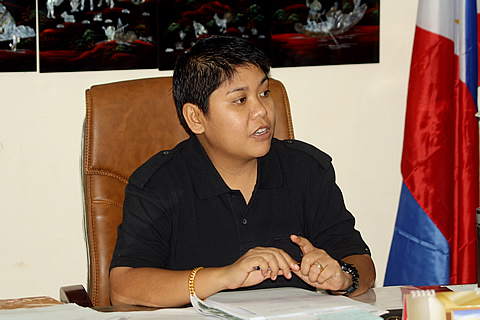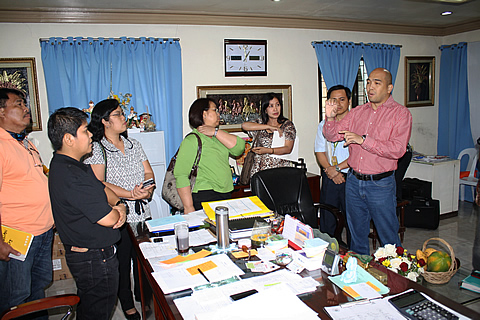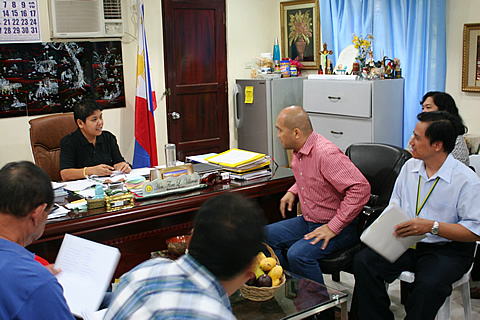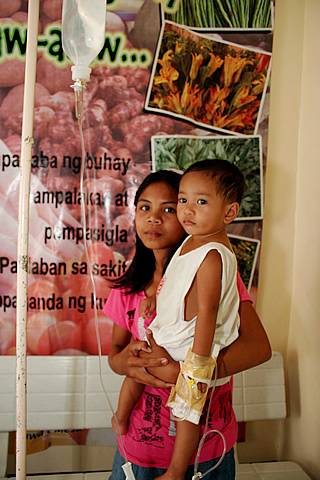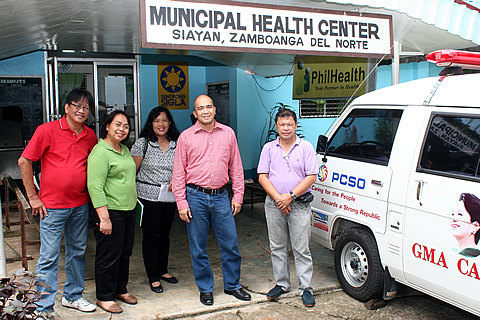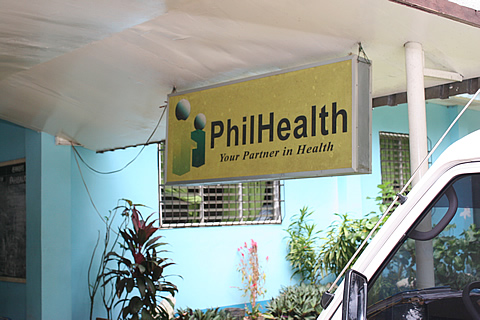PhilHealth
home | contact us | sitemap | disclaimer
News
Siayan: A story of hope and determination April 13, 2012
We are very determined to get out of the tag of being the poorest municipality in the country.
These words aptly capture what the people of Siayan Municipality in Zamboanga del Norte have always wanted and are determined to achieve in the soonest time possible, and the government is making sure that all possible help is extended for them to realize this dream.
One weekend in March, a composite team from the Philippine Health Insurance Corporation (PhilHealth) joined representatives of the Departments of Agriculture, Interior and Local Government and Social Welfare and Development on a trip to Siayan to see what interventions can be introduced to help uplift the economic condition of the municipality and its people.
Situated almost two hours away by land from Dipolog City, Siayan is a municipality characterized by hills and mountain ranges. While the road stretching from Dipolog to Siayan is paved, the access roads to most barangays are steep, muddy and very challenging even for all-terrain vehicles. This small municipality is inhabited by about 34,588 residents, 75 percent of whom belongs to the Subanen tribe. Income-wise, it is ranked 4th class, with five (5) of its 22 barangays posting 99.12 percent poverty levels. The area boasts of various mineral deposits and farming is the residents’ main source of living but the absence of farm-to-market roads in almost all barangays prevents residents from selling their products downtown.
A literacy rate of 64.65 percent, the lack of infrastructures for water and electricity, primitive farming techniques, health, sanitation and nutrition issues, and large family sizes all contribute to the municipality’s current economic condition that is why Mayor Flora L. Villarosa is bent on bringing the poverty incidence level down. “Nakakahiya kung wala akong magawa for my town," she said, adding that "on lean months, wala nang makain ang mga tao, and cassava has become an alternative carbohydrate."
Villarosa partly attributes the economic situation to the growing imbalance between the people’s needs, particularly in health, and the lack of resources to pay for health services. “Andami nilang needs especially sa health, hindi nila kayang i-finance, hindi nila kayang bayaran kahit yung kanilang hospitalization so lalong naghihirap,” she said.
A closer look at the health profile of Siayan in 2011 showed that acute respiratory infection topped the list of the leading causes of morbidity in the municipality with over 2,000 cases. This was followed by musculo-skeletal disorder and gastro-intestinal tract disorder with over 500 cases each, skin disorders and diarrhea with over 300 cases each, injuries, hypertension, urinary tract infection, pneumonia and boils.
In the area of health infrastructure, all 22 barangays have health stations with at least one midwife each. Only the Siayan Rural Health Unit, which is situated within the municipal government compound, is accredited with PhilHealth for the delivery of the outpatient benefits, the TB-DOTS, and the Maternity Care Packages.
The facility has a maternity ward, laboratory for diagnostic services, dental services area, a family planning counseling room and even an herbal garden. Two ambulances are on standby for medical emergencies. Its staffing complement includes nine midwives, eight RN Heals nurses, a medical technologist, a dentist, a sanitary inspector, and a medical doctor. In five months’ time, the facility is expected to move to its new location along the National Road and will be known as the Siayan Diagnostic and Health Center.
On the average, the Siayan RHU records about ten live births each month, but according to Dr. Raymund Nadela, the Municipal Health Officer, not all of these services have been filed with PhilHealth due to various membership concerns. On the other hand, at least 16 patients with tuberculosis have been identified although these cases have yet to be validated.
Around 5,009 families are enrolled under PhilHealth’s Sponsored Program, 93 percent of whom are listed under the National Household Targeting System for Poverty Reduction (NHTS-PR) of the DSWD. The coverage of the rest is sponsored by the local government unit and other sponsors.
Still, Villarosa is wondering why despite having a poverty incidence of almost a hundred percent, about 2,000 more poor families were not included in the NHTS-PR and are therefore without PhilHealth coverage. “Why exclude these people when we know that 97.5 percent of our population is poor? I want Siayan to be fully covered by PhilHealth” but “we are definitely not financially ready” to shoulder the premium contributions of these families. Villarosa is appealing to the DSWD to take a second look at these families for possible inclusion in the NHTS-PR so that they can be entitled to PhilHealth benefits.
Assessing the situation at hand, PhilHealth Vice President for Member Management Walter R. Bacareza proposed various interventions on PhilHealth’s side to help address concerns in Siayan. First, he said, there is a need to accredit more facilities so that benefit availments can be reimbursed by PhilHealth and the corresponding capitation fund can be used by the LGU to improve on its health facilities. The technical capability of the barangay health stations can be reviewed in preparation for their accreditation.
“The Siayan RHU, on the other hand, can work on being accredited as an MCP Plus facility where our Newborn Care Package (NCP) can also be availed of by members,” Bacareza said. PhilHealth’s case rate for NCP is worth P1,750.00, inclusive of newborn screening tests.
To directly address membership and related concerns at point-of-service, PhilHealth can link the RHU to its Dipolog Service Office for instant verification of members’ or dependents’ eligibility. This will free the member from submitting documents that may cost him a few pesos to secure, just to establish his eligibility to avail himself of PhilHealth benefits. “Pag may dumating na pasyente, kahit walang dalang PhilHealth ID o Member Data Record, o hindi niya alam ang kanyang PhilHealth Number, maseserbisyuhan pa rin siya,” he said.
Bacareza proposed that to encourage due diligence in verifying member eligibility, the LGU can assign a staffmember to handle the PhilHealth Link and incentives can be given by the LGU to ensure that these members are able to avail of the benefits especially when they need these most. The PhilHealth Link will only require an Internet connection and a scanner to facilitate transmission of documents.
Noting the need for capability-building among RHU personnel, Bacareza also said that trainings among RHU personnel can also be arranged to educate them further in preparing the documents to facilitate claims submission.
In pushing the envelope further, Bacareza explored the possibility of accrediting the Siayan LGU for the premium contributions of members in the municipality so that these members need not travel to Sindangan municipality or to Dipolog City to remit their premiums.
Meanwhile, the DSWD committed to do a resurvey since there are a lot more poor families that have to be re-assessed, while the DILG will look into the immediate provision of potable water supply, and the posting of geo-hazard maps in their website. The DA will focus on the different agri-related initiatives to help Siayan boost its agricultural capability.
The lady Mayor welcomed all these commitments. For PhilHealth, in particular, she said, “Itong aming poverty incidence right now na 97.5 percent which is the highest so far in the entire country ay gusto naming ibaba. With the help ngayon na binibigay ng PhilHealth which is from the total population... na nasa household na more than 7,000 at nakocover na ngayon ang around 4,000, napakalaking bagay na sa municipality na natutulungan kami ng national government. Definitely malaki ang tulong to reduce the poverty situation kasi hindi na problema ng ating mga kababayan yung pambayad nila sa kanilang hospitalization.”
Villarosa also expressed optimism that a year after all these interventions have been introduced, she would be able to happily report to President Noynoy Aquino how these forms of assistance helped uplift Siayan’s condition. By then, Siayan will no longer be the poorest municipality in the country. (Maria Sophia B. Varlez; photos by Juanito G. Pineda)
